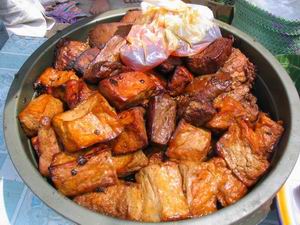Manisan for the Sweet Tooth
 Many Indonesians seem to have a constant craving for sweet foods, and to satisfy it manisan (candied fruits/vegetables) is made from various fruits and vegetables. Manisan, from the word manis (sweet), is very handy to have around on special occasions or even as a sweet ending after meals, cut or formed into small pieces, to present to the hostess.
Many Indonesians seem to have a constant craving for sweet foods, and to satisfy it manisan (candied fruits/vegetables) is made from various fruits and vegetables. Manisan, from the word manis (sweet), is very handy to have around on special occasions or even as a sweet ending after meals, cut or formed into small pieces, to present to the hostess.
Actually manisan is also one way of preserving seasonal fruits and vegetables. Next to preserving, manisan is also made to make transportation easier so the economical value will be better as epicurean and gastronome el supremo Suryatini N. Ganie explains.
Manisan is mostly made by sweetening the ingredients with granulated sugar but there are also variations of manisan that are made with herbs like screw pine leaves, suji leaves, lemon or lime leaves and spices like cinnamon and cloves. And salt is always added.
There are two types of manisan: manisan kering and manisan basah. Manisan kering is dry and tossed in granulated sugar, whereas manisan basah is soaked in a sweet brine.
Other natural preservatives like kapur sirih or slaky lime — which can be bought at traditional markets or sometimes supermarkets — may also be added.
For private use, slaky lime — which has the function of hardening soft foodstuffs like tomatoes, red and green chilies and sour fruit — is preferred. The ratio of slaky lime used is half a teaspoon to one liter of water for a quantity of one kilogram.
Today many fruits and vegetables are treated and preserved as manisan. Formerly only less salable fruits were made into manisan.
For example, pala or nutmeg. In its raw state, this fruit is less popular but when already made into manisan it is much liked after a heavy meal. But it is also said that it should be enjoyed sparingly, because manisan pala induces sleep.
Large quantities will have the same result as taking too many sleeping pills — a bit risky that is.
In well-stocked supermarkets or shops in towns like Cianjur in West Java and many towns in Aceh — where manisan is produced — 10 or 15 kinds of manisan may be displayed in large airtight glass containers. They will also have at least five or six kinds of manisan kering on hand.
Many kinds of fruits and vegetables are turned into manisan. It is best to use half-ripe fruit or ripe fruit that is hard like salak (snake fruit). Vegetables like tomatoes, papaya leaves, papaya flowers and bitter melon can also be used.
Even condiments like ginger, tamarind, chilies or seaweed can be made into manisan with good results. Papaya skin, lemon peel and watermelon rind make delectable manisan.
The best manisan comes from Aceh and Medan in North Sumatra, where, next to being delectable, the fruits or vegetables are cut into eye-catching creations, the result of years of experience in manisan making. Small children are taught by their mothers how to preserve fruits and vegetables.
One of the oldest manisan known and a childhood favorite of many is manisan asam Jawa or tamarind manisan. The tamarind is mostly made into manisan kering and is one of the easiest to make. Take one kilogram of half-ripe tamarind fruit, peel, discard pits and wash. Arrange the fruit in a deep pot. Boil one-and-a-half to two kilograms of granulated sugar in water until it forms a thick syrup, allow to cool and pour over the fruit.
Let stand for two days. Sieve and dry the fruit in the sun. Then roll the fruit in granulated sugar. Hm… sweet and sour!
Suryatini N. Ganie